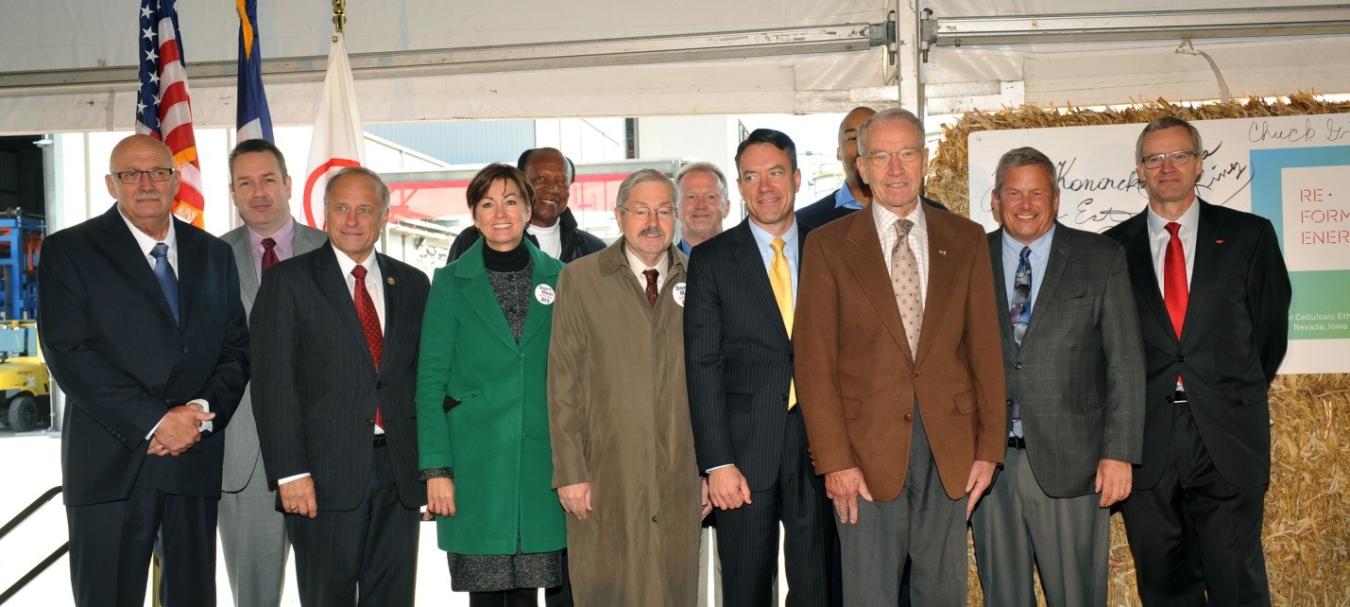On a bright, crisp October morning in Iowa, I had the privilege to speak at the grand opening of DuPont’s cellulosic ethanol biorefinery—the fourth biorefinery of its kind in the United States and the largest in the world.
Office of Critical Minerals and Energy Innovation
November 20, 2015
DuPont’s cellulosic ethanol biorefinery in Nevada, Iowa, opened on October 30, 2015.

Aerial view of DuPont’s cellulosic ethanol biorefinery in September.

Officials and DuPont employees stand by first bales of corn stover to be processed at DuPont’s 30-million-gallon cellulosic ethanol plant. Left to right: Mayor Lynn Lathrop (of Nevada, Iowa), Bioenergy Technologies Office Director Jonathan Male, Congressman Steven King of Iowa, Lt. Governor Kimberly Reynolds of Iowa, Simon Estes (Iowan opera singer who performed the National Anthem), Governor Terry Branstad of Iowa, Story County farmer Brian Sampson, President of DuPont Industrial Biosciences William Feehery, Terraun Jones (operations manager for the site), Senator Charles Grassley of Iowa, Iowa Secretary of Agriculture Bill Northey, and DuPont Global Business Director Jan Koninckx.
By Jonathan Male, director of the Bioenergy Technologies Office
On a bright, crisp October morning in Iowa, I had the privilege to speak at the grand opening of DuPont’s cellulosic ethanol biorefinery—the fourth biorefinery of its kind in the United States and the largest in the world. This impressive plant is equipped to produce 30 million gallons of ethanol each year from the leftover stalks and leaves of the corn plant, called corn stover. The U.S. Department of Energy’s Bioenergy Technologies Office has, over the years, contributed approximately $51 million to help fund the applied research and development of various technologies that will be used to convert corn stover to biofuel at DuPont’s facility.
Since the 2000s, DuPont and the National Renewable Energy Laboratory (NREL) have partnered together to develop processes to pretreat and deconstruct the corn stover and develop bacteria to ferment the cellulosic sugars to produce cellulosic ethanol. Their work was funded by multiple competitively selected Department of Energy awards and as part of the interagency Biomass Research and Development Initiative with the U.S. Department of Agriculture. More than 10 joint DuPont-NREL U.S. patents were issued from collaborative innovations.
At DuPont’s grand opening, I joined with Senator Chuck Grassley and Governor Terry Branstad of Iowa, Lt. Governor Kim Reynolds, the president of DuPont Industrial Biosciences, William F. Feehery, and the Dupont global business director for biofuel, Jan Koninckx. They and the many farmers and local community members in attendance were thrilled—as was I—to see this new plant open.
DuPont’s new biorefinery is an impressive piece of innovation, and seeing it firsthand inspired me with confidence in the advanced biofuels industry that is emerging in the United States. This is another important milestone not just for biofuels but for our country in achieving our national goals to develop innovative energy technologies and reduce greenhouse gas emissions. At the U.S. Department of Energy, we are committed to working with stakeholders across the public and private sectors to help meet the goals laid out in the President’s Climate Action Plan—goals to reduce oil imports 50% by 2020, and to reduce greenhouse gas emissions 26–28% by 2025.
Advanced biofuels, including DuPont’s cellulosic ethanol, are an important part of meeting these goals. Transportation plays an important role in our nation’s energy mix, consuming roughly two thirds of the oil used in the United States each year and producing 27% of our carbon emissions. At the Bioenergy Technologies Office, our role is to partner with technologists to accelerate commercialization of advanced biofuels that can displace foreign fossil fuels, by funding biofuel research, development, and demonstration projects at national laboratories, universities, and private companies. The funding is cost-shared by industry and universities, which means that awardees are required to secure a certain amount of private sector investment in addition to leveraging government funding.
Our approach, based on public-private partnerships, helps to advance the advanced biofuels industry in a way that enables private industry—including companies such as DuPont—to take the technology into the commercial market. We at the Energy Department have collaborated with other companies, contributing to the development and construction of the three other cellulosic ethanol biorefineries—INEOS, POET-DSM, and Abengoa.
Already, DuPont’s cellulosic ethanol biorefinery has provided economic opportunities for the area, including employing 1,000 construction workers and employees to work at the plant and purchasing corn stover from approximately 500 nearby farmers. We all know that it will still take time to develop the industry, but when I attend events like this, there is a palpable sense of excitement that a transformation of energy technologies is under way.

